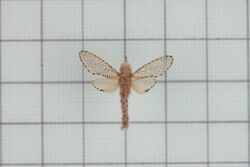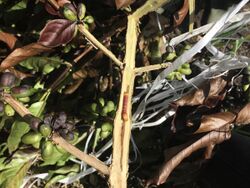Biology:Polyphagozerra coffeae
| Red coffee borer | |
|---|---|

| |
| Scientific classification | |
| Kingdom: | Animalia
|
| Phylum: | |
| Class: | |
| Order: | |
| Family: | |
| Genus: | |
| Species: | P. coffeae
|
| Binomial name | |
| Polyphagozerra coffeae Nietner, 1861
| |
| Synonyms | |
| |
Polyphagozerra coffeae, the red coffee borer or coffee carpenter, is a moth of the family Cossidae. It was described by John Nietner in 1861 and is found in Asia. Records from the Moluccas and New Guinea refer to Polyphagozerra reticulata, which was previously considered to be a synonym of P. coffeae.[1] It is a widespread pest that attacks many plants.[2]
The wingspan is 70–80 mm.[3] Females are much larger and relatively rare.[4]
Description
The characteristic feature is a forewing with vein 6 from above angle of cell. All three segments of the thorax have a pair of small black spots. The abdomen is black, clothed with white hairs. Forewings with the spots small, black and all obsolescent except those along the costa, outer margin and inner margin. Hindwing with a few obsolescent small spots and a prominent marginal series from the apex to vein 2, where they sometimes conjoined. In the female, spots of the forewing are fewer in number than the male, but more prominent and tinged with metallic blue. Larva and pupa reddish brown.[5]
Ecology
Female lay eggs on stem of the host plants. They are arranged in several rows on the branches of the plant.[6] Larvae hatch out from the eggs in about ten days. The larvae feed on a wide range of plants, including Casuarina, Erythroxylum, Acalypha, Phyllanthus, Doryalis, Hydnocarpus, Annona, Cinnamomum, Persea, Phoebe, Amherstia, Cassia, Pericopsis, Xylia, Gossypium, Hibiscus, Cedrela, Chukrasia, Melia, Swietenia, Psidium, Grevillea, Crataegus, Eriobotrya, Coffea, Citrus, Santalum, Filicium, Nephelium, Schleichera, Cestrum, Theobroma, Cryptomeria, Camellia, Clerodendrum, Lantana, Tectona and Vitex species.[7] The larvae occasionally reach pest status on coffee, tea, cotton, cocoa, kapok, coca and teak. They bore into the stem or branches of their host plant.[8]
In the Thrissur district of Kerala, India, larvae of the coffee carpenter were found damaging allspice for the first time.[9]
Pest attack
After larval attack, the crops can show many symptoms. Branches and twigs wilt quickly and become brittle resulting in them breaking off from the plant. Holes are frequently visible from which the frass is exuded. Stems show dieback due to internal feeding and finally wilt. After complete internal feeding, the dieback quickly occurs.[10]
Control
Cultural methods of control include hand picking of adults and larva immediately after an infestation is spotted or planting barrier crops such as taro, sweet potato, Leucaena glauca or Pueraria. Many parasitoids and predators are used for biological control. To control larva, Bracon zeuzerae, larva of Eulophonotus myrmeleon, and Pantorhytes species are used. Woodpeckers are also effective.[11]
References
- ↑ Yakovlev, R.V., 2011: Catalogue of the Family Cossidae of the Old World. Neue Entomologische Nachrichten, 66: 1-129.
- ↑ "Zeuzera coffeae Nietner". http://www.mothsofborneo.com/part-1/cossidae/cossidae-3-4.php. Retrieved 12 July 2016.
- ↑ Coffee pests, diseases and their management
- ↑ The Goat Moths (Lepidoptera: Cossidae) of Papua Indonesia
- ↑ Hampson, G. F. (1892). The Fauna of British India, Including Ceylon and Burma: Moths Volume I. Taylor and Francis. https://www.biodiversitylibrary.org/item/180068#page/5/mode/1up.
- ↑ "Red Borer (Zeuzera coffeae): Distribution, Life Cycle and Control". YourArticleLibrary.com. http://www.yourarticlelibrary.com/zoology/red-borer-zeuzera-coffeae-distribution-life-cycle-and-control/24052/. Retrieved 12 July 2016.
- ↑ The Moths of Borneo
- ↑ Crop Insect Pest - Plantation crops - Pest of Coffee
- ↑ "New record of the red borer Zeuzera coffeae Nietner (Cossidae: Lepidoptera) as a pest of allspice Pimenta dioica (Linn.) Merril.". CAB International.. https://www.cabdirect.org/cabdirect/abstract/19951115389. Retrieved 12 July 2016.
- ↑ "Coffee carpenter (Zeuzera coffeae)". Plantwise Knowledge Bank. http://www.plantwise.org/KnowledgeBank/Datasheet.aspx?dsid=57492. Retrieved 12 July 2016.
- ↑ "Stem Borer". cocoasafe.org. http://www.cocoasafe.org/Resources%5CDatasheets%5CStemBorer.pdf. Retrieved 12 July 2016.
Wikidata ☰ Q8069840 entry
 |


